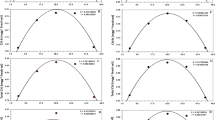Abstract
The ice plant (Mesembryanthemum crystallinum L.), a medicinal plant with well-known effects on retarding diabetes mellitus, is increasingly being produced in plant factories in Asia. The ice plant is a Crassulacean Acid Metabolism (CAM) plant, but performs C3 photosynthesis during the juvenile period. The objective of this study was to develop a photosynthetic model of ice plants growing under plant factory conditions. C3 photosynthesis was observed in juvenile plants in plant factory growth conditions and a conversion from C3 to CAM photosynthesis was observed under salt-stressed condition at an electrical conductivity (EC) of 6.0 dS·m-1. The light saturation and compensation points, determined by a regression analysis of C3 light curves for the ice plant leaves, were 609.4 and 53.2 μmol·m-2·s-1, respectively. The accuracy of the light response was compared between negative exponential and non-rectangular hyperbolic function models. The non-rectangular hyperbola was more accurate with complicated parameters while the negative exponential function was more practical with simple parameters in the light response curves. Measurement of net CO2 assimilation rate (A) and intercellular CO2 concentration (C i ) allowed construction of the A-Ci curve and regression analysis of this curve revealed the CO2 saturation and compensation points as 632.9 and 117.2 μmol·mol-1, respectively. A coupled photosynthetic model was developed for the simultaneous prediction of photosynthesis, stomatal conductance, transpiration, and temperature of the ice plant leaves. Sharkey’s regression method was used to determine the photosynthetic parameters of maximum carboxylation rate, the potential rate of electron transport, and the rate of triose phosphate utilization, which were 222.3, 234.9, and 13.0 μmol·m-2·s-1, respectively. The parameters of minimum stomatal conductance of water vapor at the light compensation point (b) and the empirical coefficient (m) for the sensitivity of stomatal conductance and relative humidity in the Ball, Woodrow and Berry model could be solved as b = 0.0487 and m = 0.0012 by linear regression analysis using the measured A-Ci values. Although the A-Ci curve of the negative exponential function had higher accuracy than the biochemical model, the coupled biochemical model could physiologically explain the photosynthesis of the ice plant leaves under plant factory conditions.
Similar content being viewed by others
Literature Cited
Ball JT, Woodrow IE, Berry JA (1987) A model predicting stomatal conductance and its contribution to the control of photosynthesis under different environmental conditions. In Biggins J, ed, Prog Photosyn Res Martinus Nijhoff Publishers, The Netherlands, pp 221–224
Caemmerer SV, Farquhar GD (1981) Some relationships between the biochemistry of photosynthesis and the gas exchange of leaves. Planta 153:376–387
Cha MK, Kim JS, Shin HJ, Son JE, Son YY (2014) Practical design of an artificial light-used plant factory for common ice plant (Mesembryanthemum crystallinum L.). Protected Hortic Plant Fac 23:371–375
Cha MK, Park KS, Cho YY (2016) Estimation of cardinal temperatures for germination of seeds from the common ice plant using bilinear, parabolic, and beta distribution models. Korean J Hortic Sci Technol 34:236–241
Cushman JC (2001) Crassulacean acid metabolism: A plastic photosynthetic adaptation to arid environments. Plant Phyisol 127:1439–1448
Evans JR, Jakobsen I. Orgren E (1993) Photosynthetic light-response curves. 2. Gradients of light absorption and photosynthetic capacity. Planta 189:191–200
Harley PC, Thomas RB, Reynolds JF, Strain BR (1992) Modeling photosynthesis of cotton grown in elevated CO2. Plant Cell Environ 23:351–363
Heuvelink E (1999) Evaluation of a dynamic simulation model for tomato crop growth a development. Ann Bot 83:413–422
Kim PG, Lee KY, Hur SD, Kim SH, Lee EJ (2003) Effects of shading treatment on photosynthetic activity of Acanthopanax senticosus. Korean J Ecol 26:321–326
Kim SH, Lieth JH (2003) A coupled model of photosynthesis, stomatal conductance and traspiration for a rose leaf (Rosa hybrida L.). Ann Bot 91:771–781
Leuning R (1995) A critical appraisal of a combined stomatalphotosynthesis model. Plant Cell Environ 18:339–355
Medlyn BE, Badeck FW, de Pury DGG, Barton CVM, Broadmeadow M (1999) Effects of elevated CO2 on photosynthesis in European forest species: a meta-analysis of model parameters. Plant Cell Environ 22:1475–1495
Nikolov NT, Massman WJ, Shoettle AW (1995) Coupling biochemical and biophysical processes at the leaf level: an equilibruium photosynthesis model for leaves of C3 plants. Ecol Modelling 80:205–235
Oh SJ, Moon KH, Koh SC (2015) Assessment of high temperature impacts on early growth of garlic plant (Allium sativum L.) through monitoring of photosystem II activities. Korean J Hortic Sci Technol 33:829–838
Rhie YH, Lee SY, Jung HH, Kim KS (2014) Light intensity influences photosynthesis and crop characteristics of Jeffersonia dubia. Korean J Hortic Sci Technol 32:584–589
Sharkey TD, Bernacchi CJ, Farquhar GD, Sinsaas EL (2007) Fitting photosynthetic carbon dioxide response curves for C3 leaves. Plant Cell Environ 30:1035–1040
Sharp RE, Mattews MA, Boyer JJ (1984) Kok effect and the quantum yield of photosynthesis. Plant Physiol 75:95–101
Thornley JHM (1976) Mathematical models. Plant physiology, Academic Press, London, p 318
Winter K, Ltittge U, Winter E (1978) Seasonal shift from C3 photosynthesis to Crassulacean Acid Metabolism in Mesembryanthemum crystallinum growing in its natural environment. Oecologia 34:225–237
Author information
Authors and Affiliations
Corresponding author
Rights and permissions
About this article
Cite this article
Park, K.S., Kim, S.K., Cho, YY. et al. A coupled model of photosynthesis and stomatal conductance for the ice plant (Mesembryanthemum crystallinum L.), a facultative CAM plant. Hortic. Environ. Biotechnol. 57, 259–265 (2016). https://doi.org/10.1007/s13580-016-0027-7
Received:
Revised:
Accepted:
Published:
Issue Date:
DOI: https://doi.org/10.1007/s13580-016-0027-7




